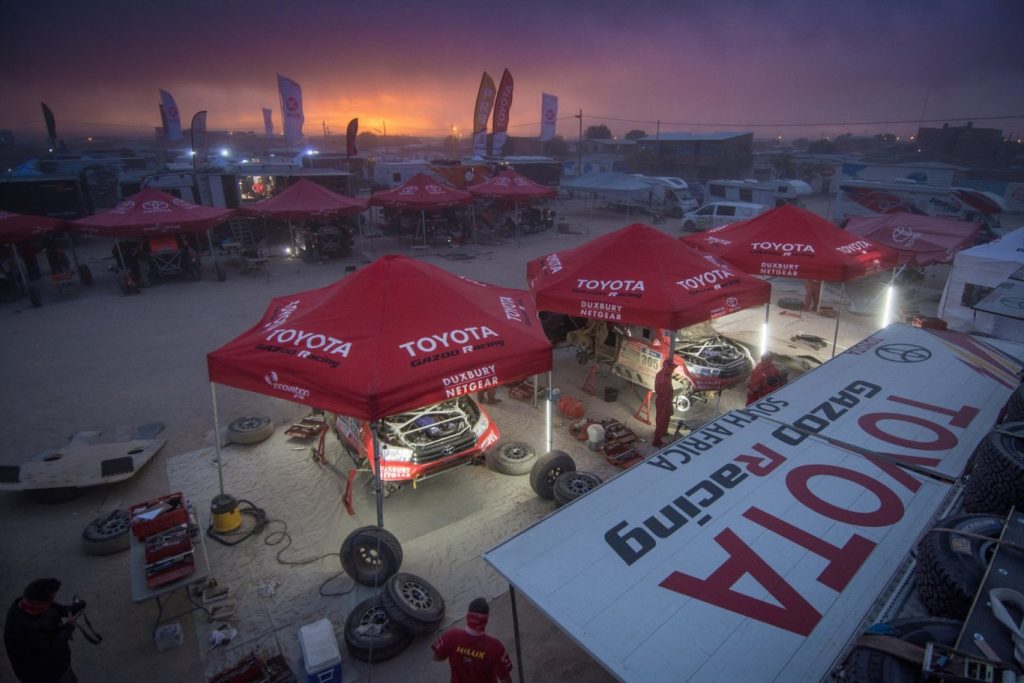SALTA, ARGENTINA – For the teams taking part in Dakar 2016, Sunday January 10th offered a moment of respite – but only for the race crews, as the service crews went into overdrive. The rest day is critical in the running of each Dakar, as the human body needs to take a break after seven days of extreme racing. But even the highly reliable Toyota Hilux race vehicles need attention after seven stages of the Dakar, and for the service crews, the rest day is an opportunity to make sure that the cars are ready to face the week ahead.
For Toyota Gazoo Racing SA, Dakar 2016 has brought mercifully few unexpected service challenges so far. Although the race is only at its midpoint, and it is way too early to relax, the three Toyota Hilux race vehicles have thus far proven extremely robust and reliable.
“We are very pleased with the way our cars have run up to this point,” said Toyota Gazoo Racing SA Team Principal Glyn Hall, from the rest day bivouac in Salta. “Were it not for a fence post that punched a hole through Leeroy and Rob’s windscreen, it would have been pure routine up to this point.”
The incident happened on Stage 6, when Leeroy Poulter and navigator Rob Howie (#319) drifted wide on the exit of a tight corner. They made contact with a fence, ripping one of the posts from the ground in the process. The post had the last laugh though, as it whipped around the car on a piece of fence that was stuck on the car, and punched a hole through the windscreen right in front of navigator Howie.
“It was just one of those things,” explained Poulter afterward. “The Dakar throws a lot of curve balls, but that was a pretty weird one. And with the broken windscreen, we struggled to see for the rest of stage 6.”
As ever, the service crew had a replacement windscreen waiting when car number 319 entered the bivouac, and it was race ready again shortly afterward. This illustrates the level of professionalism and dedication of the Toyota Gazoo Racing SA service crews, who work tirelessly despite the extreme conditions they often find themselves in.
“This year we’ve had extreme heat, flooding, dust storms, extreme cold and very high humidity,” says Toyota Gazoo Racing SA’s Crew Chief, Wimpie ‘Mac’ Botha. “And we’re only halfway through the race!”
By far the toughest bivouac so far has been the one at Uyuni in Bolivia, on the edge of the biggest salt lake in the world. The town is located at an altitude of 4,000 m above sea level, which makes it hard to do strenuous work without getting winded. What’s more, the bivouac was also hit by a dust storm of epic proportions, coating everything in a fine layer of dust and reducing visibility to less than ten meters.
During this year’s rest day, the crews stripped and rebuilt the three race vehicles, in preparation for the week ahead.
In terms of the results so far, Toyota Gazoo Racing SA has felt the effects of the high average altitudes in more ways than one. The average altitude has been way above 2,000 meters, which is the point in the regulations where normally aspirated vehicles, such as the V8-powered Toyota Hilux, are allowed to fit a bigger air intake restrictor. This would have given the team some much needed extra power, but unfortunately the route changed at the last moment, and now the team has to compete with a smaller restrictor as a result. The average altitude drops significantly over the next six stages, and the team will push hard to regain as much time as possible.
In the mean time, one of the six wheel drive support trucks (Class T4) that supply spares to Toyota Gazoo Racing SA should anything go wrong on the route, was involved in an accident on the long liaison between Uyuni in Bolivia and Salta in Argentina. There were no injuries, but some of the spares needed during the rest day were carried in the truck, placing more stress on the service crews as a result.
Dakar 2016 is now in its second half, with the stages unwinding until the race ends in the Argentine city of Rosario on Saturday, January 16th.
